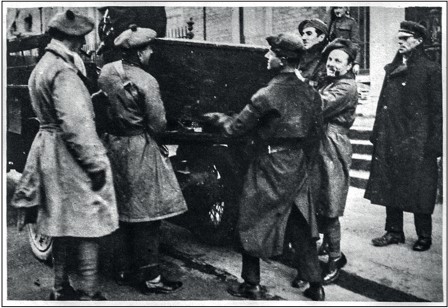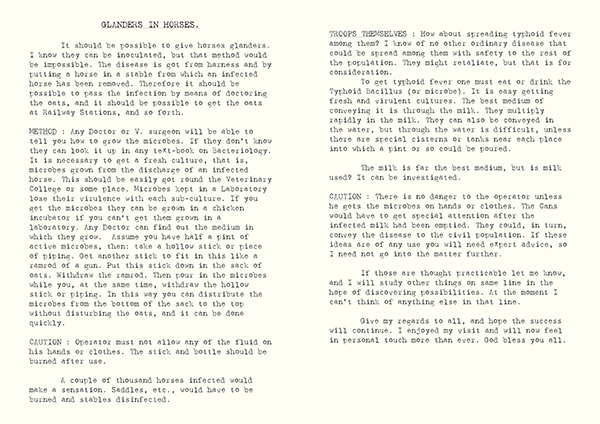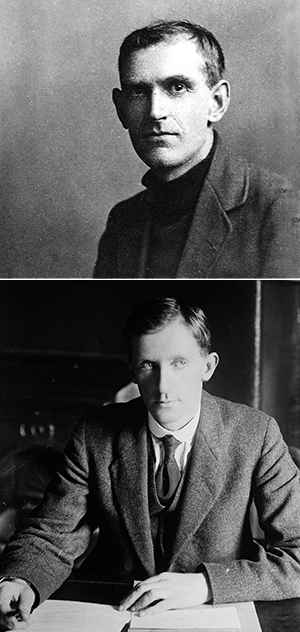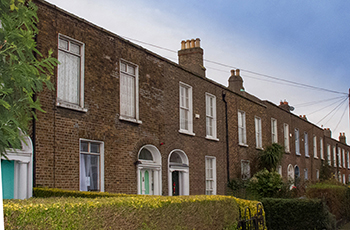The curious case of the ‘Sinn Féin typhoid plot’
Published in Features, Issue 6 (November/December 2020), Volume 28One of many examples of black propaganda by the press officials in Dublin Castle? Or has it a basis in truth?
By Michael B. Barry
As the War of Independence intensified throughout 1920, Crown forces expanded their operations in Dublin. The new force of Auxiliaries worked together with the British Army in mounting patrols, roadblocks and raids across the capital. There had been a shake-up of the Dublin Castle administration during the spring of 1920. New broom Brig.-Gen. Ormonde de l’Épée Winter had arrived in May as head of the Combined Intelligence Service and soon injected a new vigour into the British intelligence system. Amongst other initiatives, in October 1920 he set up a Raids Bureau, which organised targeted raids in Dublin based on intelligence sources. ‘It is fortunate that the Irish had an irresistible habit of keeping documents. They would hide them in the most unexpected places, but they seldom evaded discovery by the trained sleuth …’, he wrote patronisingly in his autobiography. All captured documents that came into the Bureau were carefully analysed and inserted into a card index system manned by a large number of clerks. There were nightly raids across the city. Winter claimed that in the period from October 1920 to July 1921 over 6,300 raids and searches were carried out in the Dublin district area.
Mulcahy’s papers seized

Above: The press reported the raid on ‘Professor Hayes’ house in Dublin’, but this accompanying photo showed a different raid at 42 North Great George’s Street. (Illustrated London News, 27 November 1920)
One such raid occurred at 5 a.m. on Tuesday 16 November 1920, at the Victorian red-brick terraced home of Michael Hayes at 49 Longwood Avenue, just off the South Circular Road, where IRA chief-of-staff Richard Mulcahy was in hiding. As the Crown forces arrived, Mulcahy made a swift departure out a rear window, over a wall and thence to a nearby house owned by a Jewish couple, who sheltered him. He departed later by bicycle. There were immediate reports in the press, including photographs purporting to be of the raid. According to the Irish Times, ‘a man … escaped from a window in his shirt … A search of the rooms he had occupied revealed two brown leather attaché cases, full of papers.’ Raids were happening all over Dublin and were perhaps two a penny, as the Castle press office or the newspapers got their facts mixed up—the photos used showed another November raid that was carried out by Auxiliaries at 42 North Great Georges Street (home to the Socialist Party of Ireland and various trade unions). What was particularly noteworthy, however, was that various captions referred to the raiders ‘removing the black box which contained the notorious typhoid papers’.
The British immediately claimed that they had captured papers belonging to Richard Mulcahy during the raid. In particular, they highlighted a document that proposed germ warfare against the British military, as well as plans for a series of attacks in Britain, such as the bombing of Liverpool docks. Ormonde Winter was so alarmed that he had these documents sent immediately to London by special aeroplane.
Typhoid fever and glanders
The British could not wait to publicise this document on germ warfare. On Thursday 18 November, in the House of Commons, Sir Hamar Greenwood, chief secretary for Ireland, stated: ‘The following document was found in the papers belonging to the chief-of-staff of the Republican Army, which were captured during recent raids. There follows a series of remarkable and, I think, horrifying statements which refer to the spread of typhoid fever among the troops and glanders among the horses.’ The immediate reaction from nationalist MPs was that it was a forgery. Greenwood then read out the text of the document (above/below/opposite). Joseph Devlin, leader of the Irish Parliamentary Party and member for Belfast Falls, reacted: ‘Was not the whole thing concocted in Dublin Castle? On the face of it the thing is a lie.’
The press duly reported Hamar Greenwood’s assertions, using headlines like ‘Sinn Féin Plot to Spread Typhoid Among Troops’. One piece in the Times mused on the spread of glanders and said that ‘on two occasions the Germans were found to be employing glanders against the British Army’. One of these was the ‘infection of a shipload of mules from Argentina to Mesopotamia’. International newspapers picked up the story on the wire service. ‘Says Irish Planned to Spread Microbes’, ran a headline in the 19 November New York Times. A certain level of panic set in. An ‘alarming outbreak of typhoid’ in the Skibbereen district of West Cork was reported in newspapers on 25 November. This led to an investigation by the authorities, but no evidence was uncovered ‘to connect the outbreak with the alleged plot by the Sinn Féin [sic] to spread typhoid germs’.

Above: A reworking of the original captured document. A copy had been reproduced (in negative format, white text on black background, the copying technology of the time) in the 27 November issue of the Illustrated London News.
The ongoing propaganda war
Joseph Devlin’s scepticism was an understandable reaction to any pronouncement by Dublin Castle, particularly when this supposed document verged towards the exotic end of atrocity stories. There had been many examples of black propaganda by the press officials in the Castle. A minor engagement by the Auxiliaries with the IRA on 12 November at Ballymacelligot creamery, near Tralee, was presented in press reports as a resounding victory for the Crown forces. Photographs in the press showed Auxiliaries rounding up men in civilian dress, with bodies lying around, as part of the ‘Battle for Tralee’. It soon emerged that these photographs had been taken at Vico Road in Killiney. The official response was to deny knowledge of the photographs. The official Weekly Summary issued by the Castle press office was a byword for crude falsities, which had led to many in the international press depending on the Sinn Féin-produced Irish Bulletin for reliable facts. In a later raid in 1921 the Crown forces seized the Bulletin’s typewriter, roneo and address list. The Castle press officers (Captains Darling and Pollard) issued a series of fake editions of the Irish Bulletin from the end of March 1921. It was easily spotted: one MP requested the authorities ‘not to waste their money in sending me any more of their forgeries’.
And then, days after Hamar Greenwood’s unveiling of the ‘typhoid plot’, on the morning of Sunday 21 November the IRA assassinated British secret service officers across Dublin and the events of Bloody Sunday unfolded. The assassinations, the shootings at Croke Park and the killings of Dick McKee, Peadar Clancy and Conor Clune in Dublin Castle soon dominated the headlines. As this and other events in Ireland, like Kilmichael and the burning of Cork, rolled on, the alleged ‘Sinn Féin typhoid plot’ was forgotten and, certainly in Ireland, regarded as buried among the other British attempts at black propaganda.
But was the document genuine?

Above: According to Richard Mulcahy (above), the document was an unsolicited discussion paper from Pat McCartan (top) to Michael Collins, which ended up in Mulcahy’s waste-paper basket in Longwood Avenue. (Library of Congress, NLI)
Fast-forward to the present. In the course of my research, I came across the witness statement (BMH WS 1713) of James O’Donovan, IRA Director of Chemicals at the time. Amidst his description of experimenting with explosives and chemicals, he insouciantly states that during the conscription crisis in 1918:
‘Consideration was also given to the possibility of infecting the horses in the various cavalry barracks with glanders or some similar infectious disease. Another aspect of bacteriological warfare was the possibility under consideration of spreading disease, e.g. botulism, on which I wrote a couple of articles about 1918.’
Interestingly, he noted that:
‘Another thing I was put on was the making of poison-gas, tear gas and things like that. I took it that we were going to use these gases, and I did not think very much of the possibilities, but I learned from Dick Mulcahy … that what we were really working on was to take safeguards against poison-gas, the use of which, during the imminent imposition of conscription, was expected.’
I also came across the witness statement (BMH WS 865) of John Plunkett, brother of the executed Joseph Plunkett. In his gossipy account, he refers to the raid in which
‘[Dick Mulcahy] barely escaped capture, leaving his attaché case with all his papers behind him. These papers contained various plans of proposed operations against the British, one of which was Dick’s own proposal to put typhoid germs in the water supply of Portobello Barracks. Dick had been a First-Medical student and somebody remarked about his suggestion, “What else could you expect from a First Medical”.’
Mulcahy papers
My curiosity was aroused by the fact that these two witness statements lent some credibility to the typhoid document. I then visited the UCD Archives to search amongst the Richard Mulcahy papers there. The documents P7/D/42 reference a conversation in 1962 between Mulcahy and Máire Bean Uí Brugha, daughter of Terence Mac Swiney. Mulcahy told of his experience during the raid at Longwood Avenue, where ‘the house was surrounded about 5 o’clock in the morning and raided and I got through the back window’. He had a couple of papers with him in the house; one was for
‘… plans for breaking the docks at Liverpool in circumstances in which if you blew it up in certain ways, that a liner would be tossed over on its side … Another of the papers was a thing that Pat McCartan had sent to Mick Collins showing how the horses of the British Military could be infected by glanders, and how the milk supplied to Dublin barracks could be infected by typhoid. Mick had written on Pat McCartan’s note “this is your department!” … I had marked it up at the top “medical” and put it into the waste paper basket system. And this was the joke as far as Mick and myself were concerned …’

49 Longwood Avenue today—
where IRA chief-of-staff Richard Mulcahy
evaded arrest on 16 November 1920.
Thus the document was genuine but was merely an unsolicited discussion paper by Patrick McCartan. It bears the stamp of someone who had a medical background. McCartan was indeed a medical doctor from County Tyrone, elected to the First Dáil. He was appointed Sinn Féin’s representative in the USA. In February 1921 he had travelled to Russia, at de Valera’s request, to negotiate a treaty with the Bolsheviks, which did not materialise. There is a similarity between the contents of the captured document and the 1918 thoughts of James O’Donovan, so it is likely that McCartan had heard of these or had had a conversation with O’Donovan. It appears that the practical military men, Collins and Mulcahy, engaged in directing an intensive guerrilla war, had already discounted the document and its concept of germ warfare by the time it was captured by the British. Mulcahy’s instruction to James O’Donovan in 1918 to only work on defensive measures against poison gas indicates that Mulcahy did not seriously countenance these barbaric means of warfare.
When the document was examined after the 16 November raid, it is certain, given the febrile atmosphere pervading Dublin Castle, that spymaster Ormonde Winter was indeed shocked enough to courier it to London post-haste. Hamar Greenwood, in turn, lost no time in divulging the document in parliament. The British would probably have made more of a propaganda meal of the ‘plot’ had not other events overwhelmed them. There was now new propaganda to be made and new events to be spun. And so the ‘Sinn Féin typhoid plot’ faded from history.
Michael B. Barry’s An illustrated history of the Irish revolution, 1916–1923 has just been published by Andalus Press.
FURTHER READING
M. Hopkinson, The Irish War of Independence (Dublin, 2004).
M.G. Valiulis, Portrait of a revolutionary: General Richard Mulcahy and the founding of the Irish Free State (Dublin, 1992).
O. Winter, Winter’s tale: an autobiography (London, 1955).
















